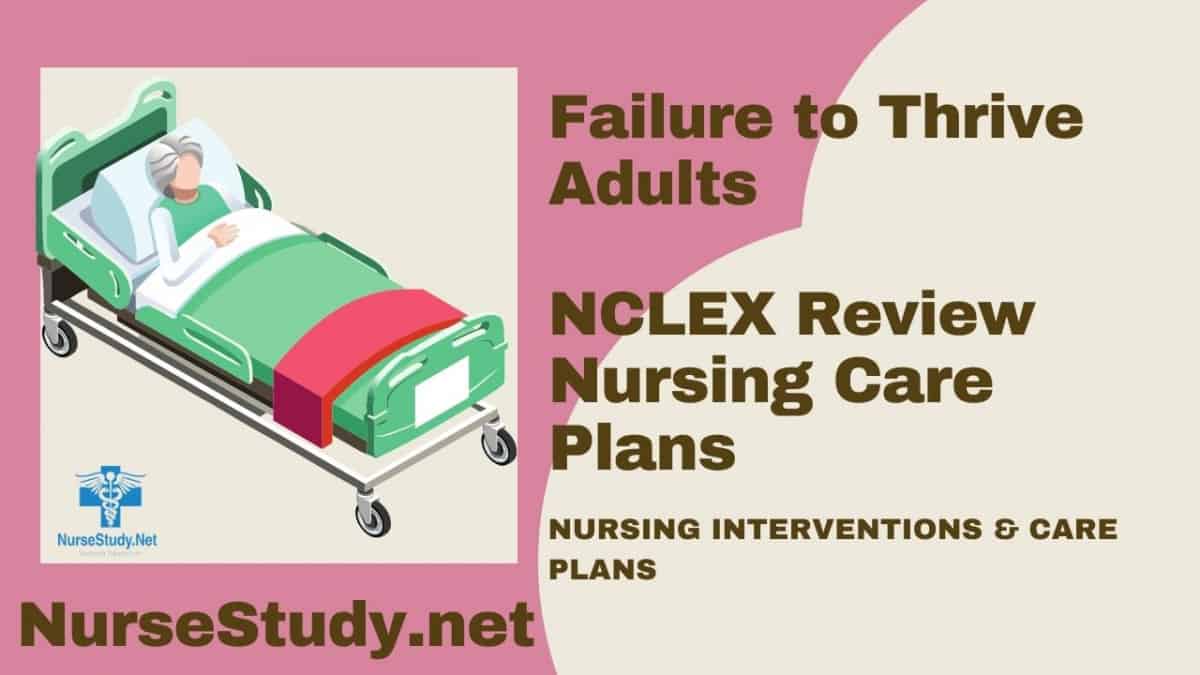Failure to thrive (FTT) in adults is a complex condition characterized by physical and cognitive decline, decreased functional status, and poor nutritional intake. This comprehensive nursing diagnosis guide focuses on identifying key symptoms, implementing effective interventions, and improving patient outcomes.
Causes (Related to)
Adult failure to thrive can result from various factors:
- Medical Conditions
- Psychosocial Factors
- Social isolation
- Loss of independence
- Financial constraints
- Grief or loss
- Elder abuse
- Functional Decline
- Reduced mobility
- Decreased muscle strength
- Impaired cognition
- Poor self-care ability
Signs and Symptoms (As evidenced by)
Subjective: (Patient reports)
- Decreased appetite
- Unintentional weight loss
- Fatigue
- Depression
- Social withdrawal
- Loss of interest in activities
- Difficulty performing daily tasks
Objective: (Nurse assesses)
- Weight loss >5% in one month or >10% in 6 months
- Decreased muscle mass
- Poor skin turgor
- Cognitive decline
- Reduced physical activity
- Poor nutritional intake
- Decreased functional status
- Laboratory abnormalities
Expected Outcomes
Successful management of adult failure to thrive includes:
- Weight stabilization or gain
- Improved nutritional status
- Enhanced functional independence
- Increased social engagement
- Better quality of life
- Improved mood and cognition
- Prevention of complications
Nursing Care Plans
Nursing Care Plan 1: Impaired Nutritional Status
Nursing Diagnosis Statement:
Impaired nutrition: less than body requirements related to decreased oral intake and metabolic changes as evidenced by unintentional weight loss >5% in one month and decreased appetite.
Related Factors:
- Poor appetite
- Difficulty swallowing
- Depression
- Chronic illness
- Medication side effects
Nursing Interventions and Rationales:
- Monitor weight daily
Rationale: Tracks nutritional status and intervention effectiveness - Provide small, frequent, nutrient-dense meals
Rationale: Increases caloric intake without overwhelming patient - Implement oral care before meals
Rationale: Enhances taste perception and appetite - Document intake and preferences
Rationale: Identifies patterns and facilitates meal planning
Desired Outcomes:
- The patient will demonstrate weight gain or stabilization
- The patient will increase daily caloric intake
- The patient will report an improved appetite
Nursing Care Plan 2: Impaired Physical Mobility
Nursing Diagnosis Statement:
Impaired physical mobility related to muscle weakness and decreased endurance as evidenced by difficulty performing ADLs and decreased activity tolerance.
Related Factors:
- Muscle weakness
- Fatigue
- Pain
- Fear of falling
- Depression
Nursing Interventions and Rationales:
- Assess mobility level daily
Rationale: Monitors progress and identifies needs - Implement a progressive mobility program
Rationale: Builds strength and endurance safely - Provide assistive devices
Rationale: Promotes independence and safety
Desired Outcomes:
- The patient will demonstrate improved strength
- The patient will increase activity tolerance
- The patient will perform ADLs with minimal assistance
Nursing Care Plan 3: Chronic Pain
Nursing Diagnosis Statement:
Chronic pain related to underlying medical conditions as evidenced by verbal reports of pain and decreased activity level.
Related Factors:
- Chronic medical conditions
- Musculoskeletal disorders
- Depression
- Anxiety
- Immobility
Nursing Interventions and Rationales:
- Assess pain regularly
Rationale: Ensures appropriate pain management - Administer prescribed medications
Rationale: Controls pain and enables activity - Teach non-pharmacological pain management
Rationale: Provides additional pain control methods
Desired Outcomes:
- The patient will report decreased pain levels
- The patient will demonstrate improved activity tolerance
- The patient will use effective pain management strategies
Nursing Care Plan 4: Social Isolation
Nursing Diagnosis Statement:
Social isolation related to functional decline and decreased mobility as evidenced by expressed feelings of loneliness and reduced social interactions.
Related Factors:
- Physical limitations
- Depression
- Loss of independence
- Transportation issues
- Communication difficulties
Nursing Interventions and Rationales:
- Encourage social interactions
Rationale: Reduces isolation and improves mood - Facilitate participation in activities
Rationale: Provides social engagement opportunities - Connect with support services
Rationale: Establishes community resources
Desired Outcomes:
- The patient will increase social interactions
- The patient will participate in group activities
- The patient will express decreased feelings of loneliness
Nursing Care Plan 5: Self-Care Deficit
Nursing Diagnosis Statement:
Self-care deficit related to physical and cognitive decline as evidenced by the inability to complete ADLs independently.
Related Factors:
- Weakness
- Fatigue
- Cognitive impairment
- Depression
- Pain
Nursing Interventions and Rationales:
- Assess self-care abilities
Rationale: Identifies specific needs and support required - Provide adaptive equipment
Rationale: Facilitates independence - Teach energy conservation techniques
Rationale: Maximizes ability to perform self-care
Desired Outcomes:
- The patient will demonstrate improved self-care abilities.
- The patient will use adaptive equipment effectively
- The patient will maintain personal hygiene independently
References
- Ackley, B. J., Ladwig, G. B., Makic, M. B., Martinez-Kratz, M. R., & Zanotti, M. (2020). Nursing diagnoses handbook: An evidence-based guide to planning care. St. Louis, MO: Elsevier.
- Tsui C, Kim K, Spencer M. The diagnosis “failure to thrive” and its impact on the care of hospitalized older adults: a matched case-control study. BMC Geriatr. 2020 Feb 14;20(1):62. doi: 10.1186/s12877-020-1462-y. PMID: 32059639; PMCID: PMC7023702.
- Sarkisian CA, Lachs MS. “Failure to thrive” in older adults. Ann Intern Med. 1996 Jun 15;124(12):1072-8. doi: 10.7326/0003-4819-124-12-199606150-00008. Erratum in: Ann Intern Med 1996 Oct 15;125(8):701. PMID: 8633822.
- Silvestri, L. A. (2020). Saunders comprehensive review for the NCLEX-RN examination. St. Louis, MO: Elsevier.
- Thertus, K., Giddens, N. T., Hennen, R., & Hazarika, O. D. (2023). (115) Failure to Thrive and Malnutrition in an Adult with OCD: An Inpatient Multidisciplinary Approach to Management of Co-morbid ARFID in the General Hospital. Journal of the Academy of Consultation-Liaison Psychiatry, 64, S57. https://doi.org/10.1016/j.jaclp.2023.11.588
